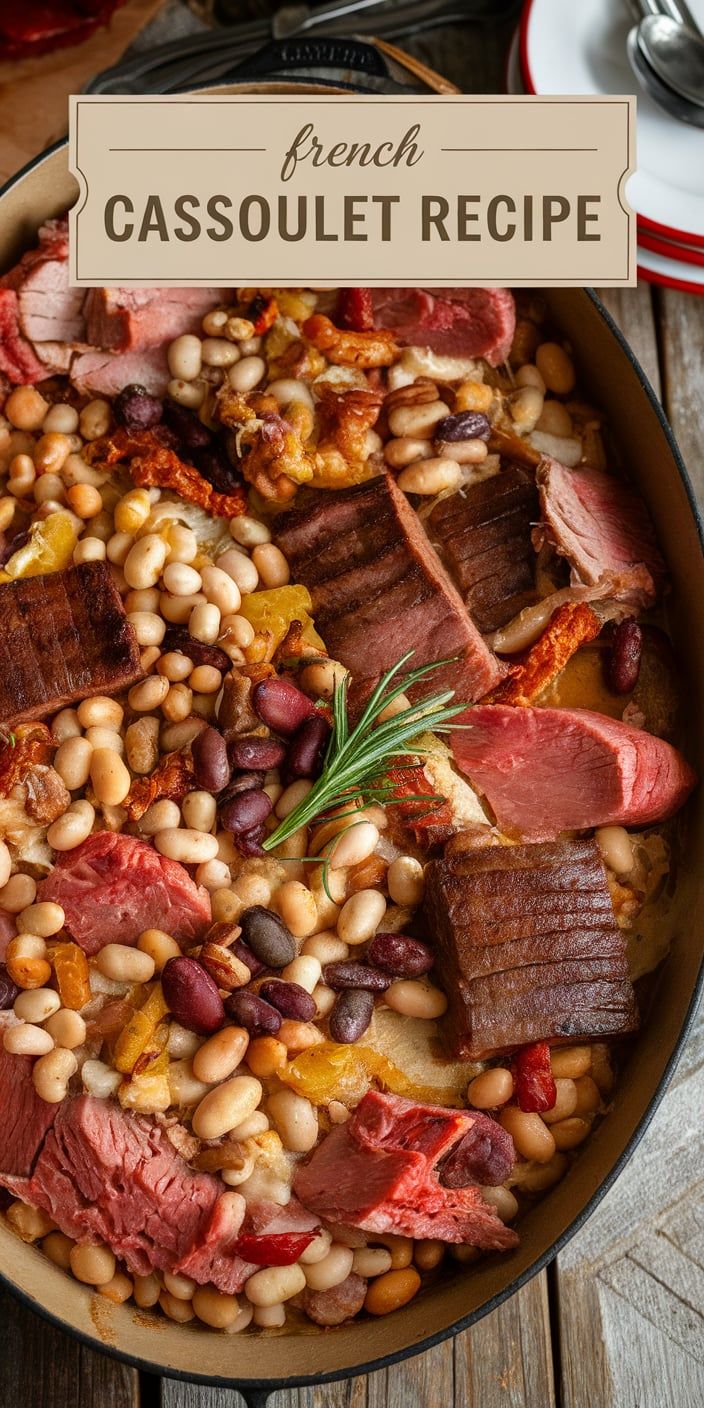Discover the rich culinary tradition of Southern France with an authentic French cassoulet, a hearty traditional French stew that warms both body and soul. This iconic dish represents the heart of rustic French cooking, bringing together robust flavors and time-honored cooking techniques passed down through generations.
The homemade cassoulet is more than just a meal—it’s a culinary journey through the French countryside. Originating in the Languedoc region, this classic comfort food combines tender beans, succulent meats, and aromatic herbs into a truly memorable dining experience.
Each spoonful of this traditional French stew tells a story of regional pride, family traditions, and the art of slow cooking. Our comprehensive recipe will guide you through creating an authentic French cassoulet that captures the essence of classic French cuisine.
Key Takeaways
- Authentic French cassoulet originates from Southern France
- Requires slow cooking for maximum flavor development
- Combines beans, meat, and aromatic herbs
- Represents a cornerstone of rustic French culinary tradition
- Can be adapted with regional ingredient variations

Understanding the Traditional French Cassoulet Recipe
Dive into the rich culinary world of cassoulet, a hearty French dish that represents more than just a meal—it’s a celebration of regional traditions and cooking heritage. This iconic comfort food tells a story of rural French cuisine, deeply rooted in local ingredients and time-honored cooking techniques.
Exploring Cassoulet Origins
The cassoulet origins trace back to the southwestern regions of France, particularly Languedoc. Named after the traditional earthenware cooking vessel called a cassole, this dish emerged as a peasant meal that transformed simple ingredients into a luxurious culinary experience.
- Developed in rural southwest France
- Created as a hearty, economical meal
- Reflects local agricultural traditions
Essential Cassoulet Ingredients
Cassoulet ingredients are carefully selected to create a rich, complex flavor profile. The core components typically include:
- White beans
- Duck or goose confit
- Pork sausages
- Preserved meats
Regional Cassoulet Variations
Regional cassoulet variations showcase the diversity of French culinary traditions. Each region brings its unique twist to this classic dish:
- Toulouse: Focuses on duck and pork
- Carcassonne: Includes lamb and local sausages
- Castelnaudary: Considered the original cassoulet recipe
A true cassoulet is more than a recipe—it’s a culinary journey through French regional history.
Step-by-Step French Cassoulet Recipe
Creating an authentic cassoulet recipe requires patience and attention to detail. This classic French dish transforms simple ingredients into a rich, hearty meal that will transport your taste buds to the southwest of France.
Ingredients for an Authentic Cassoulet
- 2 cups dried white beans (preferably Tarbais beans)
- 1 pound duck confit
- 1/2 pound pork sausage
- 1 large onion, diced
- 4 garlic cloves, minced
- 2 carrots, chopped
- Fresh thyme and bay leaves
- Salt and black pepper to taste
How to Make Cassoulet: Preparation Steps
- Prepare the Beans: Soak white beans overnight in cold water. Drain and rinse thoroughly.
- In a large Dutch oven, simmer beans with aromatics until tender (approximately 1-2 hours).
- Brown the sausage and duck confit in a separate pan to develop deep flavors.
- Layer beans and meats carefully in a traditional earthenware cassole or heavy casserole dish.
- Create a crispy breadcrumb topping by mixing fresh breadcrumbs with herbs and olive oil.
The cassoulet cooking instructions demand slow, careful preparation. Bake the dish at 325°F for approximately 2-3 hours, periodically breaking the crust that forms on top. This technique ensures a rich, deeply flavored cassoulet that captures the essence of traditional French country cooking.
Pro tip for cassoulet recipe success: Allow the dish to rest for 15-20 minutes after cooking. This helps the flavors meld and makes serving easier. Each bite should showcase tender beans, succulent meats, and a perfectly crisp top layer.
Conclusion
Creating an authentic French cassoulet is more than just following a recipe—it’s about embracing a rich culinary tradition. The key to a perfect serving cassoulet lies in patience, quality ingredients, and a passion for French cooking. Your dedication to slow-cooking and carefully selecting meats and beans will transform this rustic dish into a truly memorable meal.
When it comes to cassoulet wine pairing, select robust red wines that can stand up to the dish’s intense flavors. A Southwestern French wine like Cahors or a Languedoc red will complement the hearty cassoulet beautifully. For best results, choose wines with good tannin structure that can cut through the richness of the meat and beans.
Cassoulet storage is straightforward and actually enhances the dish’s flavor. Store leftovers in an airtight container in the refrigerator for up to 3-4 days. Many home cooks find that cassoulet tastes even better the next day, as the flavors continue to meld and develop. When reheating, do so gently in the oven to maintain the dish’s signature texture and depth of flavor.
Embrace this classic French culinary adventure with confidence. While the process might seem complex, the step-by-step guide provides all the tools you need to create an authentic cassoulet that will impress family and friends. Remember, cooking is about enjoyment—so have fun, experiment, and make this recipe your own!
